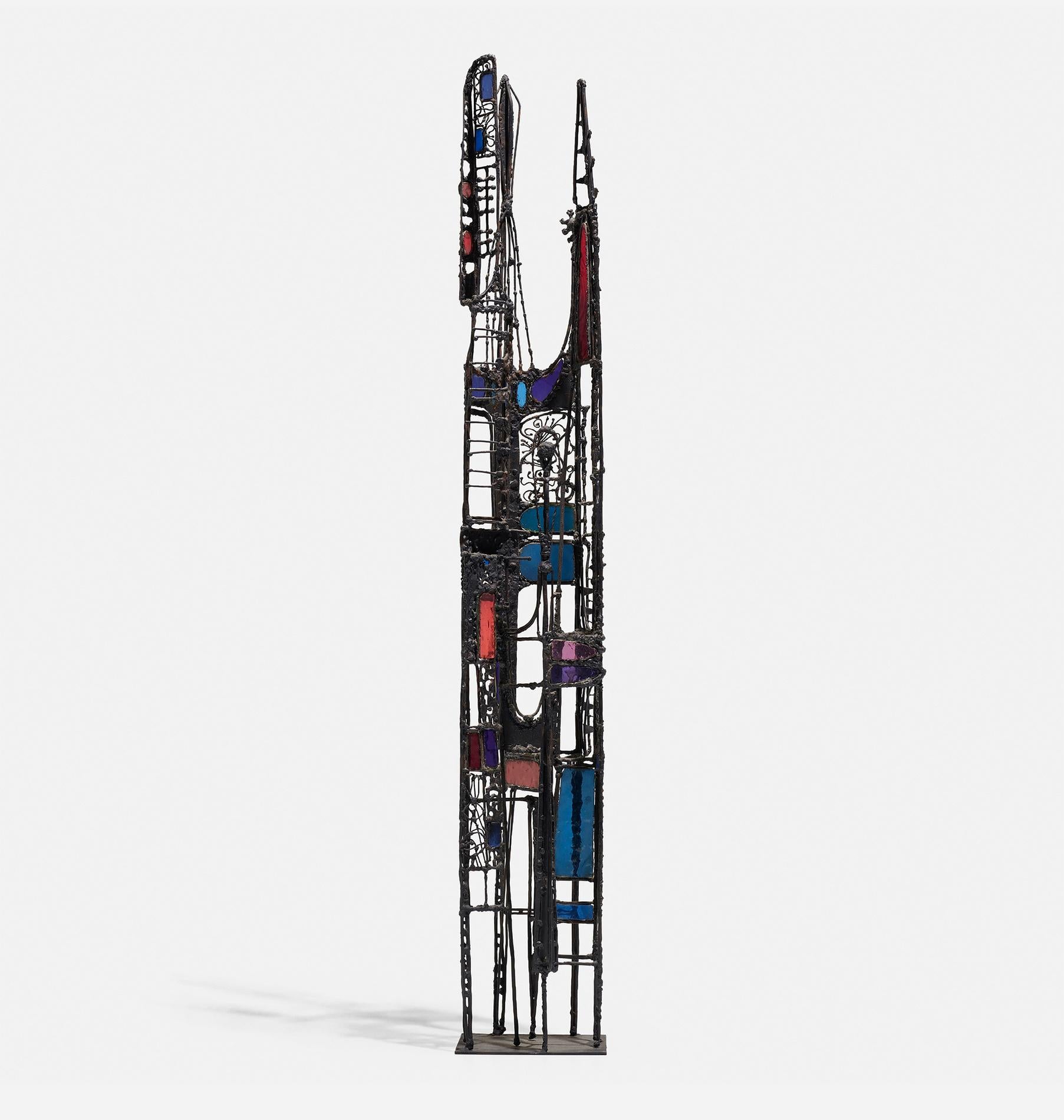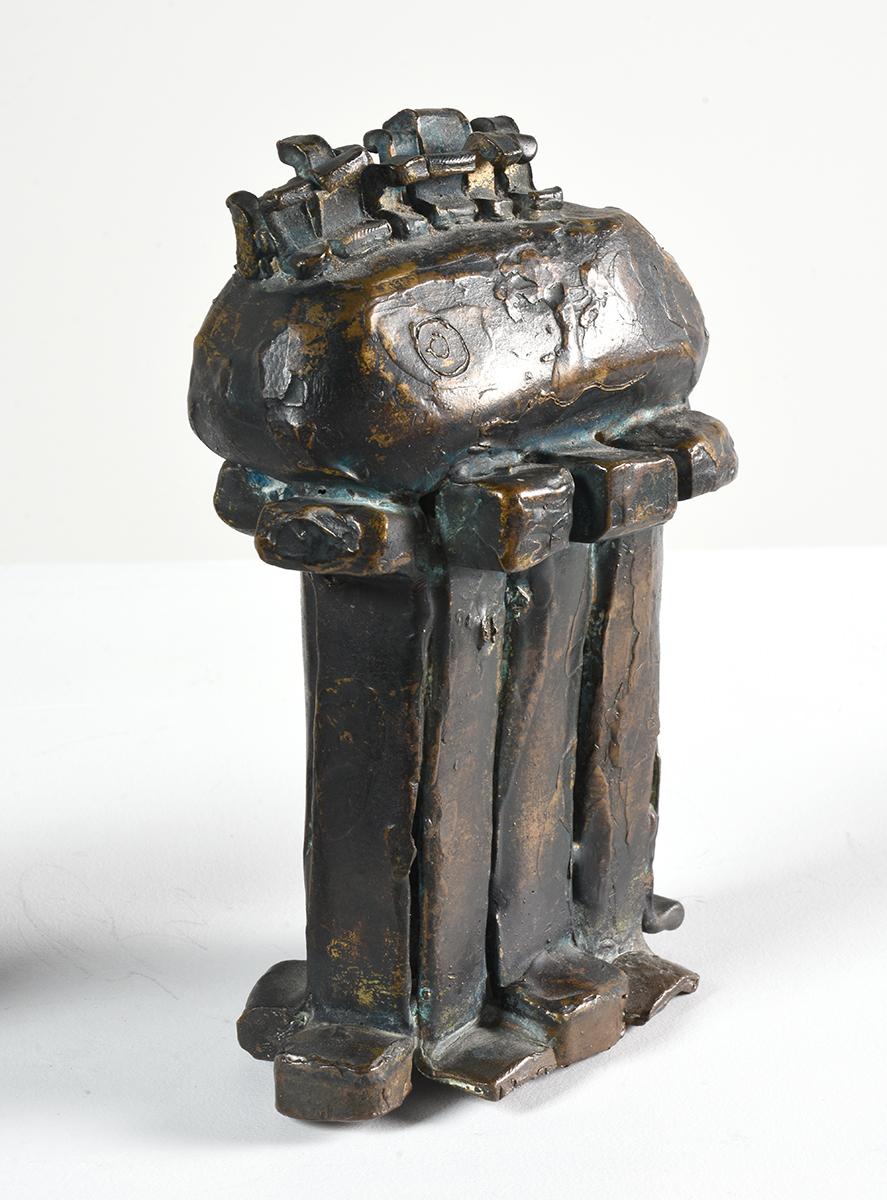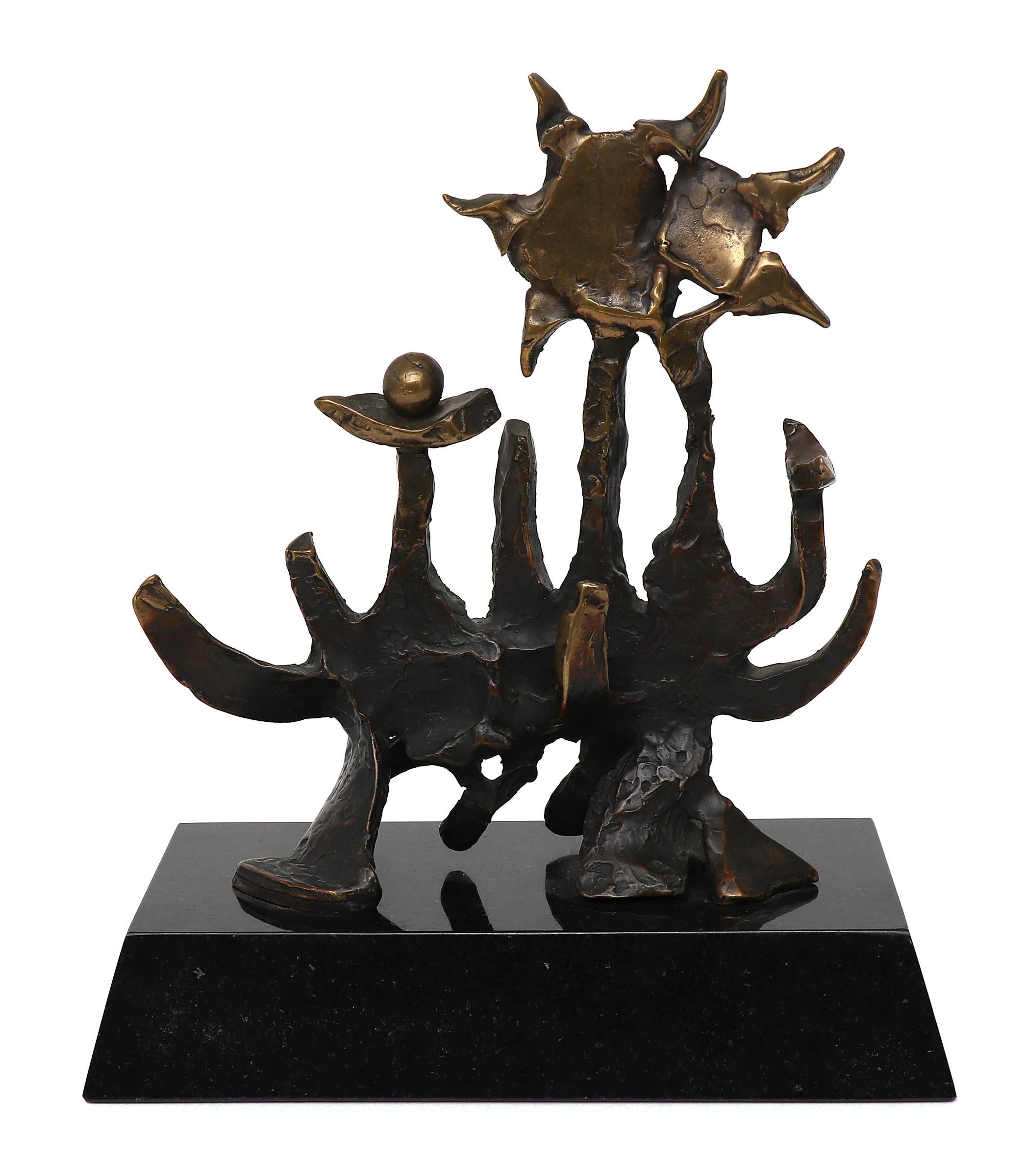Items Similar to John-Paul Philippe, "Untitled", table top abstract steel sculpture on wood base
Want more images or videos?
Request additional images or videos from the seller
1 of 8
John-Paul PhilippeJohn-Paul Philippe, "Untitled", table top abstract steel sculpture on wood base
About the Item
"Untitled" is an abstract steel sculpture on a wood base by New York based contemporary artist John-Paul Philippe. The artist was born in 1955 and began his career as a painter.Due to a chance encounter with Barneys New York's creative director John-Paul Philippe embarked on a long time collaboration with the brand, which led to a series of three dimensional explorations. Like his paintings, his sculptures are filled with the curvy, organic shapes of early modernism.
Signed "JP" on the wood base.
Circa 1990s.
- Creator:John-Paul Philippe (1955, American)
- Dimensions:Height: 17 in (43.18 cm)Width: 7.5 in (19.05 cm)Depth: 7 in (17.78 cm)
- Medium:
- Movement & Style:
- Period:
- Condition:
- Gallery Location:Glenview, IL
- Reference Number:
About the Seller
5.0
Vetted Seller
These experienced sellers undergo a comprehensive evaluation by our team of in-house experts.
Established in 2018
1stDibs seller since 2019
72 sales on 1stDibs
- ShippingRetrieving quote...Ships From: Glenview, IL
- Return PolicyA return for this item may be initiated within 10 days of delivery.
More From This SellerView All
- Jason Clay Lewis "Murdered Rappers", inscribed bullets in acrylic case sculptureLocated in Glenview, IL"Murdered Rappers" by contemporary American artist Jason Clay Lewis is a table top conceptual sculpture consisting of 15 bullets, each inscribed with the name of a murdered rapper, m...Category
1960s Conceptual Abstract Sculptures
MaterialsSteel
- Rimas VisGirda, "A Cup and It's Shadow", original stoneware with gold lusterBy Rimas VisGirdaLocated in Glenview, IL"A Cup and It's Shadow" by Lithuanian-American sculptor and ceramist Rimas VisGirda is a whimsical take on a cup on a plate that blurs the line between pottery and sculpture. The sto...Category
Late 20th Century Contemporary More Art
MaterialsCeramic
- Bruce Houston "Untitled (Homage to Frank Stella)", mixed media sculptureBy Bruce HoustonLocated in Glenview, IL"Untitled (Homage to Frank Stella)" by contemporary American artist Bruce Houston is a mixed media sculpture created with wood, paint and toy parts in 1989.Category
1980s Contemporary Abstract Sculptures
MaterialsMixed Media
- William Jacobs "Urban Scene II", original pastel on paperBy William JacobsLocated in Glenview, IL"Urban Scene II" by noted Chicago painter William Jacobs (1897 - 1973) is a pastel on paper created in 1972. The artwork is signed and dated in pencil by t...Category
1970s American Modern Landscape Drawings and Watercolors
MaterialsPastel
- William Jacobs "Urban Scene", original pastel on paperBy William JacobsLocated in Glenview, IL"Urban Scene" by noted Chicago painter William Jacobs (1897 - 1973) is a pastel on paper created in 1970. The artwork is signed in pencil by the artist and...Category
1970s American Modern Landscape Drawings and Watercolors
MaterialsPastel
- William Jacobs "A Stroll in the Park", original pastel on paperBy William JacobsLocated in Glenview, IL"A Stroll in the Park" by noted Chicago painter William Jacobs (1897 - 1973) is a pastel on paper created in 1970. The artwork is signed and dated i...Category
1970s American Modern Landscape Drawings and Watercolors
MaterialsPastel
You May Also Like
- Mid-Century Metal and Colored Glass Sculpture - Like Stained GlassLocated in Miami, FLMid-Century enameled steel, glass sculpture that is visually balanced from 360 degrees. All the positive and negative spaces work in total harmony which is a testament to Samuel Cashwan...Category
1950s American Modern Abstract Sculptures
MaterialsSteel
- American Modern Abstract Metalwork Sculpture, Mid Century Modern Table SculptureBy Angelo Di BenedettoLocated in Denver, COOriginal vintage abstract metalwork sculpture by artist Angelo Di Benedetto (1913-1992). Measures 13 ¼ x 11 ¼ x 7 ½ inches. About the Artist: Born New Jersey 1913 Died Central City, CO 1992 The son of Italian immigrants from the Salerno province in southern Italy, as a teenager Di Benedetto worked to study at the Cooper Union Art School in New York City (1930-34) from which he graduated with a certificate in freehand drawing. He won a scholarship to the Boston Museum Art School where he studied for three years, beginning in 1934. In 1937, he entered his first juried exhibition at the Montclair Museum in New Jersey, winning first prize and first honorable mention. In December 1938, the Royal Netherlands Steamship Line sent him on a two-month ethnological study trip to Haiti, his first exposure to a different environment outside the United States. In 1940, his Haitian paintings were exhibited at the Montross Gallery in New York – his first solo show. Before World War II, Di Benedetto traveled extensively around the United States doing regional paintings. During the war in 1941, Di Benedetto volunteered for a secret mission based in Eritrea, Africa before the Allied invasion. Following Africa, he served as an orientation officer and aerial photographic officer in the District of Columbia. In 1945 he was assigned to a mapping unit at Buckley Airfield in Denver where he served until his discharge in 1946. Like many other servicemen stationed at the time in Colorado, Di Benedetto chose to remain in Colorado, impressed by the state’s physical grandeur and healthful climate. He settled in the old mining town of Central City in 1947. In 1949 Di Benedetto and his wife, ceramist Lee Porzio, opened the Benpro Art School in his studio where he conducted summer art classes. In 1950, Di Benedetto teamed up with Frank Vavra...Category
20th Century American Modern Abstract Sculptures
MaterialsMetal
- Eugene Caples "Bronze Sculpture I" Abstract Bronze SculptureBy Eugene CaplesLocated in Detroit, MISALE ONE WEEK ONLY This small exquisite "Bronze Sculpture I" is in excellent condition and a perfect example of Eugene Caples craftsmanship. Although it is mainly abstract, there are bits that look figurative either an arm or a leg attempting to emerge from a fold or attempting to hold a pose such as in yoga. It cries out to be touched and held, looked at and caressed. The beautiful patina on the surface gives voice to the many hands that have done these things. Eugene Caples is a designer and craftsman who worked in Kansas City in the 1960s and later through the early 21st century. He attended the Kansas City Art Institute, earning his Bachelors of Fine Arts in Industrial Design in 1959. In 1963 he was accepted to Cranbrook Academy of Art, Bloomfield Hills, Michigan. The Cranbrook Academy of Art was designed by architect and faculty member, Eliel Saarinen who collaborated with Charles and Ray Eames on chair and furniture design. Numerous creative artists are alumni of Cranbrook and include: Harry Bertoia, Florence Knoll, Jack Lenor Larsen, Donald Lipski, Duane Hanson, Nick Cave, Hani Rashid, George Nelson, Urban Jupena (Nationally recognized fiber artist), Artis Lane (the first African-American artist to have her sculpture, "Sojourner Truth," commissioned for the Emancipation Hall in the Capital Visitor Center in Washington DC), Cory Puhlman (televised Pastry Chef extraordinaire), Thom O’Connor (Lithographs), and Paul Evans (Created Brutalist-inspired sculpted metal furnishings.) Gene worked...Category
Late 20th Century American Modern Abstract Sculptures
MaterialsBronze
- Eugene Caples "Bronze Sculpture II" Abstract Bronze SculptureBy Eugene CaplesLocated in Detroit, MISALE ONE WEEK ONLY This small exquisite "Bronze Sculpture II" is in excellent condition and a perfect example of Eugene Caples craftsmanship. This is mainly abstract with some graphic or architectural elements and is so delightful that mythical creatures demand to be considered. It cries out to be touched and held, looked at and caressed. The beautiful patina on the surface gives voice to the many hands that have done these things. Eugene Caples is a designer and craftsman who worked in Kansas City in the 1960s and later through the early 21st century. He attended the Kansas City Art Institute, earning his Bachelors of Fine Arts in Industrial Design in 1959. In 1963 he was accepted to Cranbrook Academy of Art, Bloomfield Hills, Michigan. The Cranbrook Academy of Art was designed by architect and faculty member, Eliel Saarinen who collaborated with Charles and Ray Eames on chair and furniture design. Numerous creative artists are alumni of Cranbrook and include: Harry Bertoia, Florence Knoll, Jack Lenor Larsen, Donald...Category
Late 20th Century American Modern Abstract Sculptures
MaterialsBronze
- American Modern Abstract Bronze Sculpture on Granite Stand, Edward ChavezBy Edward Arcenio ChavezLocated in Denver, COAbstract bronze sculpture mounted on granite base by Edward (Eduardo) Arcenio Chavez (1917-1995). Measures 7 ½ x 6 x 2 inches, including stand. Sculpture is in very good to excellent condition - please contact us for a detailed condition report. About the Artist: Born 1917 Died 1995 Born in Wagonmound, New Mexico, Eduardo Chavez...Category
20th Century American Modern Abstract Sculptures
MaterialsGranite, Bronze
- The Test, Assembled Kinetic Modernist Sculpture Puzzle ConstructionBy William King (b.1925)Located in Surfside, FL"The Test," 1970 Aluminum sculpture in 5 parts. Artist's cipher and AP stamped into male figure, front, 20 5/16" x 12 1/2" x 6 5/7" (approx.) American sculptor King is most noted for his long-limbed figurative public art sculptures depicting people engaged in everyday activities such as reading or conversing. He created his busts and figures in a variety of materials, including clay, wood, metal, and textiles. William Dickey King was born in Jacksonville, Florida. As a boy, William made model airplanes and helped his father and older brother build furniture and boats. He came to New York, where he attended the Cooper Union and began selling his early sculptures even before he graduated. He later studied with the sculptor Milton Hebald and traveled to Italy on a Fulbright grant. Mr. King worked in clay, wood, bronze, vinyl, burlap and aluminum. He worked both big and small, from busts and toylike figures to large public art pieces depicting familiar human poses — a seated, cross-legged man reading; a Western couple (he in a cowboy hat, she in a long dress) holding hands; a tall man reaching down to tug along a recalcitrant little boy; a crowd of robotic-looking men walking in lock step. Mr. King’s work often reflected the times, taking on fashions and occasional politics. In the 1960s and 1970s, his work featuring African-American figures (including the activist Angela Davis, with hands cuffed behind her back) evoked his interest in civil rights. But for all its variation, what unified his work was a wry observer’s arched eyebrow, the pointed humor and witty rue of a fatalist. His figurative sculptures, often with long, spidery legs and an outlandishly skewed ratio of torso to appendages, use gestures and posture to suggest attitude and illustrate his own amusement with the unwieldiness of human physical equipment. His subjects included tennis players and gymnasts, dancers and musicians, and he managed to show appreciation of their physical gifts and comic delight at their contortions and costumery. His suit-wearing businessmen often appeared haughty or pompous; his other men could seem timid or perplexed or awkward. Oddly, or perhaps tellingly, he tended to depict women more reverentially, though in his portrayals of couples the fragility and tender comedy inherent in couplehood settled equally on both partners. His first solo exhibit took place in 1954 at the Alan Gallery in New York City. King was elected to the American Academy of Arts and Letters in 2003, and in 2007 the International Sculpture Center honored him with the Lifetime Achievement in Contemporary Sculpture Award. Mr. King’s work is in the collections of the Metropolitan Museum of Art, Guggenheim Museum, Whitney Museum and the Museum of Modern Art in New York and the Hirshorn Museum at the Smithsonian American Art Museum in Washington, among other places, and he had dozens of solo gallery shows in New York and elsewhere. Reviews of his exhibitions frequently began with the caveat that even though the work was funny, it was also serious, displaying superior technical skills, imaginative vision and the bolstering weight of a range of influences, from the ancient Etruscans to American folk art to 20th-century artists including Giacometti, Calder and Elie Nadelman. The New York Times critic Holland Cotter once described Mr. King’s sculpture as “comical-tragical-maniacal,” and “like Giacomettis conceived by John Cheever.”Category
1970s American Modern Figurative Sculptures
MaterialsMetal
Recently Viewed
View AllMore Ways To Browse
Sculpture On Table
Wood Sculpture Base
Table Base Sculpture
Table Top Sculpture
Abstract Table Sculpture
Abstract Table Base
Table Top Wood Sculptures
John Born Table
John Paul Philippe
Peter Churcher
Plaster Man
Dove Sculpture
Old Master Paintings Venice
Old Masters Paintings Of Venice
Royal Palm
Vintage Advertising Framed Posters
Cubist Gold
Stack Of 3 Art





